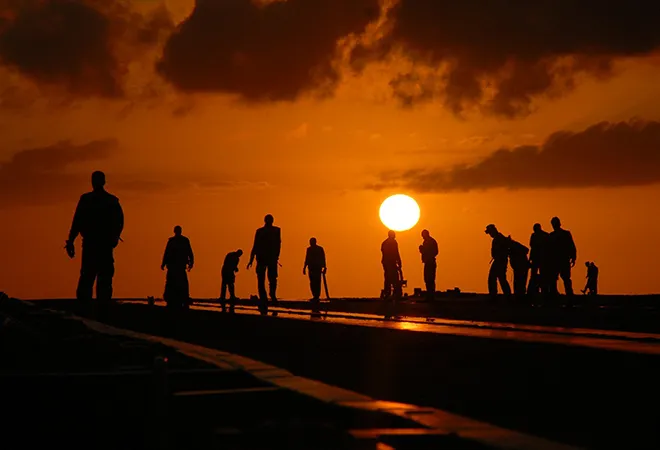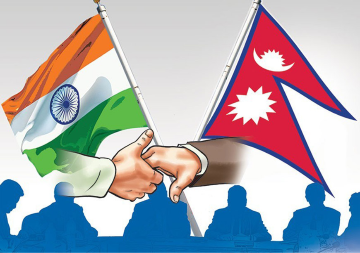
The novel coronavirus that first emerged in China in November 2019, has struck down aircraft carriers more effectively than any complicated system of surveillance, targeting and firepower ever could. Militaries around the world will need to react faster than ever before to tackle this invisible threat.
As of April 2020, an incredible four nuclear-powered aircraft carriers worldwide have been sidelined in a matter of weeks, and not a single US Navy carrier is operationally deployed in the Pacific Ocean. Adversary military planners and practitioners could hardly hope for such incredible success in achieving mission kills against one or two carriers, let alone four.
The first carrier to report a COVID-19 infection was the USS Theodore Roosevelt in March 2020, leading to a well-publicised series of events that first saw the ship’s commanding officer, Captain Brett Crozier, relieved of command for an impassioned letter he addressed to various levels of US Navy leadership, which was subsequently leaked. Less than a week after sacking the captain, acting Navy Secretary Thomas Modly resigned, after audio of a tirade he delivered aboard the Roosevelt when it was docked at Guam was leaked to the press. The same day, the US Navy announced that Crozier had tested positive for COVID-19 and was in quarantine on Guam. On 13 April, with a tenth of the ship’s crew confirmed as infected, the US Navy announced that a sailor from the USS Theodore Roosevelt had died — the first coronavirus fatality among active-duty members of the US Military.
Next was the USS Ronald Reagan, which reported its first cases shortly after the Roosevelt did, followed by the USS Nimitz on 7 April. USS Carl Vinson, which is in dry dock and not expected to deploy until late in the year, also reported a COVID-19 case in March. While Reagan is docked at its home port at Yokosuka, Japan for scheduled maintenance, measures to tackle the spread of COVID-19 will likely see its ability to deploy at short notice negatively affected. Nimitz was preparing to deploy from its base in Bremerton, Washington, and the quarantine resulting from the outbreak has already delayed its deployment. The sole remaining West Coast carrier, USS Abraham Lincoln, has just completed a record-setting 295-day deployment to the Middle East and will not be sent back for operations, leaving the US Navy with no operational nuclear-powered carriers in the Pacific.
The final carrier to be struck down was the French Navy flagship Charles de Gaulle, forced to cut short its deployment in early April as it registered a large number of COVID-19 cases on board. The carrier had been deployed since January, initially in the Mediterranean, where it operated alongside the US Navy carrier USS Dwight D Eisenhower, before heading to the North Sea for an exercise with Standing NATO Maritime Group One (SNMG1) in advance of its move into the Atlantic. Although a planned port call in Denmark was cancelled as a result of COVID-related precautions, the carrier’s crew have certainly interacted with a significant number of other ships as well as made numerous other port calls in the three-odd months since it left its Toulon base. In fact, a crew member tested positive on the Belgian frigate Leopold I, which was operating with Charles de Gaulle in March.
The maritime domain certainly complicates efforts to limit the spread of the virus, but it is not the only affected area. COVID-19 has led to a slew of cancelled military exercises across the globe, and even forced the US-led coalition in Iraq to withdraw troops early. Over 150 US bases across all branches of service have declared COVID cases, with more than 3,000 service personnel affected.
Indian concerns
Given the situations on board various ships around the world — not just warships or aircraft carriers but also the infamous Diamond Princess cruise liner case — it is clear that distancing requirements to limit the spread of COVID-19 are simply not feasible at sea. It is of critical importance to the Indian Navy and Coast Guard therefore, to ensure that a repeat of the Theodore Roosevelt does not occur under an Indian ensign. The Navy Chief has already released a video urging his personnel to ensure operational naval platforms remain free of the virus. But with the Navy’s extensive involvement in the national response to COVID-19 there are no guarantees against infection, and the Navy’s leadership, especially field commanders far from New Delhi, need to be prepared to act with speed and transparency to ensure that outbreaks are dealt with in ways that would minimise human costs, even if it means a near term drop in fleet availability.
The same applies to bases near the borders, particularly toward Pakistan, where COVID-19 seems to have done nothing to dampen Pakistani enthusiasm for terrorist infiltration or ceasefire violations along the LoC. These areas will not only need to focus on staying free of the coronavirus, they must also be prepared to react rapidly in quarantining and de-inducting large amounts of personnel if necessary. It is worth noting that despite outbreaks in areas such as Leh with a large military presence, as well as the military’s enormous contribution to COVID relief operations, infection rates are remarkably low. If India is to cement its place at the head of regional efforts, this must remain so. Indian Air Force transport hubs that are proving so crucial to the disbursement of COVID-related supplies across the country, need to remain alert against infection, because as India’s capacity and willingness to address outside contingencies increases, airlift will be the principal means of delivering aid.
In the longer term, overall military readiness will certainly present a challenge, particularly with regard to China. As the originator and earliest victim of the virus, China has also been the first to emerge on the other side of COVID-19’s ravages, notably with its military capabilities seemingly unaffected. On 3 April, a Chinese coast guard vessel rammed and sank a Vietnamese fishing boat near the disputed Paracel Islands in the South China Sea. A week later, the PLA Navy sailed a carrier group past Japan and Taiwan, prompting both countries to publicly register concern and underscoring the complete lack of America’s carriers in the Western Pacific.
The Chinese carrier Liaoning was accompanied by two destroyers, two frigates and a supply ship as it made its way to the South China Sea. It is likely escorted by one or more submarines as well. Chinese state-run media also published carefully timed editorials highlighting US woes in dealing with COVID-19, and noting bluntly that “China will naturally expand the range and intensity of its activity, and will safeguard its inherent maritime interests more resolutely and pursue a more open and inclusive international maritime security order.”
It is imperative therefore, to ensure that the present situation is managed so that the military’s ability to handle its traditional role is not eroded when the time comes.
The views expressed above belong to the author(s). ORF research and analyses now available on Telegram! Click here to access our curated content — blogs, longforms and interviews.




 PREV
PREV


